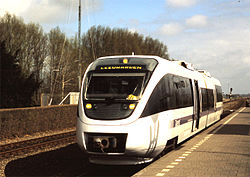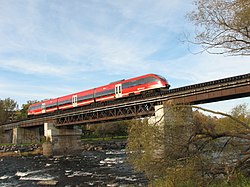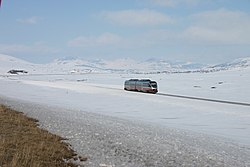This article needs additional citations for verification .(December 2024) |
| Talent | |
|---|---|
 A Talent ÖBB 4024 EMU. | |
| Manufacturer | Bombardier Talbot |
| Designer | Alexander Neumeister |
| Constructed | 1996-2008 |
| Number built | 830+ |
| Successor | Talent 2 |
| Specifications | |
| Train length | 34.61–66.87 m (113 ft 7 in – 219 ft 5 in) |
| Maximum speed | 140 km/h (90 mph) |
| Weight | 57–116 t (56–114 long tons; 63–128 short tons) |
| Axle load | 12.8–14.1 t (12.6–13.9 long tons; 14.1–15.5 short tons) |
| Power output | 630 kW (840 hp) (diesel-mechanical) 1,100 kW (1,500 hp) (diesel-electric) 1,520 kW (2,040 hp) (electric) |
| Transmission | Diesel-mechanical or Diesel-electric |
| Electric system(s) | 15 kV 16.7 Hz AC and 25 kV 50 Hz AC, both from overhead catenary |
| Current collection | Pantograph (electric) |
| UIC classification | B'2'B' B'2'2'B' Bo'2'2'2'Bo' |
The Talent is a multiple unit light train manufactured by Bombardier that was developed by Waggonfabrik Talbot in Aachen shortly before the company was acquired by Bombardier in 1995. The name Talent is an acronym in German for TALbot LEichter Nahverkehrs-Triebwagen (in English, Talbot light suburban self-propelled car).
Contents
It comes in a number of variants, including high-floor, low-floor, diesel-mechanical, diesel-hydraulic, diesel-electric, electric, and tilting, and in lengths of two, three, or four carriages. As with most multiple-unit trains, Talent units can run individually, or be coupled together to form longer trains.






